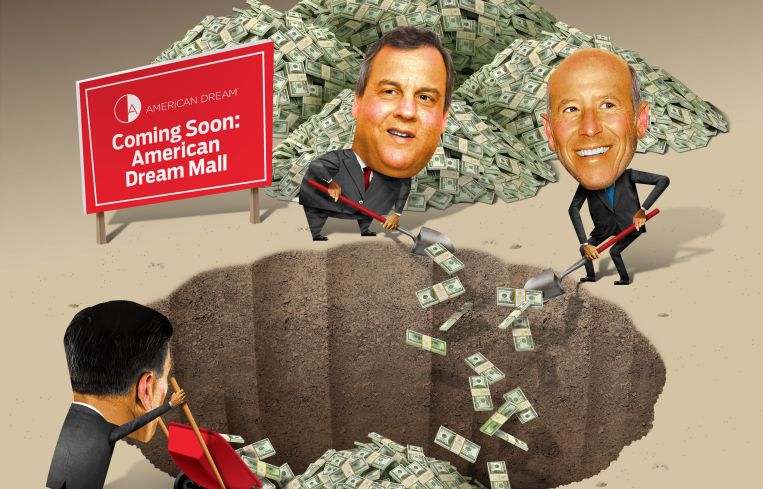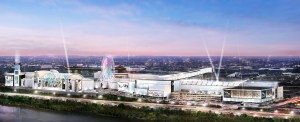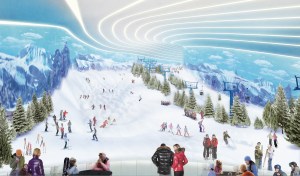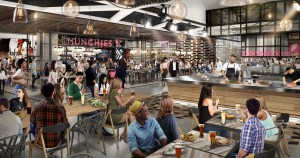After 16 Years of Construction, American Dream Mall Will Finally Open. Will It Work?
Shopping malls might be living a nightmare, but New Jersey’s American Dream Mall is trying to do something bigger, better and more entertaining. Will it succeed?
By Nicholas Rizzi February 12, 2019 9:00 am
reprints
The American Dream Mall—once given a deadline to open in 2014 when the Super Bowl was played in New Jersey—has become the butt of many Northern New Jersey residents’ jokes. It’s been empty for years, little more than a garish, multi-colored eyesore to the drivers on the New Jersey Turnpike.
But finally, after 16 years of starts and stops, missed deadlines, three developers, five governors and a major retail contraction, current developer Triple Five claims the $5 billion American Dream Mall in East Rutherford, N.J., will open its 3.1-million-square-foot center in April. That includes 1.5 million square feet of retail, the largest indoor amusement park in the Western Hemisphere, an indoor ski lift, a DreamWorks-branded indoor waterpark, a Cirque du Soleil venue and a National Hockey League-sized ice rink. Subsequent phases call for two hotels and a convention center.
“There’s a lot that you can see with your eye to let you know this thing is coming soon,” said David Townes, a senior director of retail at Cushman & Wakefield whose office is next to the American Dream site in the Meadowlands Complex.
But even as it nears the finish line, not everybody’s convinced the American Dream Mall will really come to fruition. (At least not on the April timetable.)
“We’ve been told this story a gazillion times,” Jersey City Mayor Steven Fulop, who recently criticized the project on Twitter, told Commercial Observer. “I gloss over these dates on when they’re projected to open.”
Whether or not American Dream does open its doors this year, it’s already far from where it began its life as Xanadu in 2003, owing in part to the changing retail landscape. Traditional mall anchors like Macy’s, J.C. Penney and Sears have shuttered locations, with Sears declaring bankruptcy last year, while brick-and-mortar retailers across the country have been flailing. Enclosed malls have been closing across the country, leading many experts to posit they may be going extinct.

“There haven’t been many new enclosed malls to open in the country over the last 10 years,” said Thomas Dobrowski, who handles regional mall investment sales at Newmark Knight Frank. “The consensus is there’s not a need for more enclosed malls.”
But don’t tell that to Triple Five. The developer is owned by the Ghermezian family and Don Ghermezian, the CEO, has said in multiple interviews that he doesn’t consider American Dream a mall at all. Unlike at its other developments, Mall of America and West Edmonton Mall, Triple Five dedicated the majority of American Dream Mall—55 percent—to entertainment.
“With American Dream, we’ve taken that model and kind of put it on its head a little bit,” said Dimitri Lalagos, the senior vice president for leasing at American Dream. “We are building a destination that contains significantly more than just shopping.”
That tactic seems to be the best bet for success. Malls around the world have started to add amenities like coworking, waterslides, movie theaters and more to draw shoppers through the door, which Dobrowski said has been working.
Plus, Class A malls around Northern New Jersey haven’t faced quite as much distress as other areas in the country, and a complex like American Dream is nowhere to be found in the New York and New Jersey market.
“People are waiting for something like this,” said Richard Latella, an executive managing director on C&W’s valuation and advisory retail team. “I know it’s going to do tremendously well right out of the block.”
And even though American Dream is asking for rents higher than at nearby malls like Garden State Plaza, it has already secured leases from brands like Saks Fifth Avenue, Hermès and Barneys New York. C&W’s Townes has plenty of retailer clients looking to lease space in the area and currently has several deals in the works at American Dream.
“There’s a lot of excitement and anticipation [about American Dream],” he said. “There’s a lot of tenant interest and a lot of tenant commitments.”
Triple Five’s optimism hasn’t stopped some critics (including one former Triple Five employee) from questioning the viability of the project, former New Jersey Gov. Chris Christie’s decision to give millions of dollars in tax breaks to the developer, and the state giving $800 million in redevelopment bonds.
“I think it’s a ridiculous idea that we’re subsidizing and bonding for this American Dream project,” Fulop said. “Retail and malls are struggling nationally with technology and the internet. The fact that Jersey is going so deep in building a new mall to me makes very little sense.”
Fulop argued that though “retail is dying at a less-fast pace” in New Jersey than it is in the rest of the country, that doesn’t make it completely immune. As evidence he points to retail store closures nearby at Jersey City’s Newport Centre like Teavana.
“All these malls have difficulties,” he said. “Sometimes you gotta be a realist and say it doesn’t make sense to throw good money at bad money and that decision needs to be made at some point.”
(A spokeswoman for New Jersey Gov. Phil Murphy did not respond to a request for comment.)
Other things that could hold the American Dream back are infrastructure issues and Bergen County’s blue law, which requires retailers to close on Sundays.
“You have to generate sales in six days that many others have seven days to do,” C&W’s Latella said. “It will make it tougher.” (However, the law doesn’t apply to the entertainment at American Dream Mall, which means it would be unaffected.)
Latella estimated American Dream would need to pull similar numbers to Triple Five’s Mall of America—40 to 50 million visitors a year—to be a success. To be in that ballpark it will need to draw residents from New Jersey and New York as well as tourists.
Lalagos pointed to the “tremendous amount of traffic” around American Dream. “It’s about 100 million cars per year,” he noted.
Triple Five pitches itself as being only five miles away from Times Square, but Fulop said the distance is “one of the most densely populated five miles in the country” that’s already marred by poor public transportation and traffic jams.
“It still could take you an hour to get there,” he said. “New Jersey Transit struggles daily; it’s not going to be an effective alternative for people.”
Still, brokers in the area and a former aide to Christie are confident that the project will succeed and be a boon to the area. Triple Five has estimated it will create 23,000 construction jobs, 16,000 permanent jobs and bring in $183 million in annual taxes, Bloomberg reported.
“I think it will be a success for both the project as well as the surrounding area,” said real estate developer and investor Jon Hanson, who was in charge of the project during the Christie administration. “More and more development will result.”

After two developers couldn’t finish the mall, Christie tasked Hanson to get it back on track in 2009. But when Hanson’s team estimated it would cost $50 million to $100 million to demolish, Christie looked to restart the project that year.
Hanson got pitches from several other candidates that mostly focused on retail but chose Triple Five because of its history of adding entertainment aspects to its projects.
“In hindsight, I think we made the right decision,” Hanson said, referring to retail’s recent struggles. “The success of the American Dream would be the heavy emphasis on the entertainment.”
Not everybody is as sure as Hanson that Triple Five—founded in 1972 in Canada by Iranian immigrant Jacob Ghermezian—was the right choice. The company made its name with the 5.5-million-square-foot West Edmonton Mall in Alberta, which opened in 1981, and the 4.5-million-square-foot Mall of America in Minnesota. Both projects had features unique to malls at the time like rollercoasters, indoor wave pools and miniature golf courses.
Despite those projects’ successes, former American Dream employee Norman Krone said he wrote a letter to Christie in 2011 urging him not to pick Triple Five for Xanadu.
“My opinion was that they would never complete the work,” said Krone, currently a lawyer in Florida. “The other key thing that I suggested to the governor was they would be asking for substantial sums of money from the state and I urged him not to do it; it was not in the best interest of New Jersey.”
Krone worked for Triple Five for four years in China trying to get malls built, but they all fell through. Most faltered because Triple Five didn’t want to foot the entire bill and the Chinese government would not give them any money, Krone said. He subsequently left the company in frustration in 2012.
And it wasn’t just in China that Triple Five failed to finish projects. In early 2009, the developer killed plans to build an $800 million complex in Las Vegas called the Great Mall of Las Vegas, blaming decreased demand and the recession, the Las Vegas Review-Journal reported. Triple Five later lost the land in foreclosure.
Triple Five also failed to build a mall in Niagara Falls, N.Y., called Fantasyland, in the 1980s and its first American Dream project in Silver Springs, Md., in the 1990s, according to public radio station WHYY.
“We are very, very selective in the projects we do and where we go,” Ghermezian told online news publication NJ Spotlight in 2016. “The other markets that we didn’t end up ultimately exercising and moving forward [with were because] market conditions that at the time warranted that we pull back or not move forward.”
Christie did not heed Krone’s warning and later announced he would give Triple Five up to $390 million in tax breaks, the Associated Press reported.
“They’ve gotten a lot more money than I ever expected them to get,” Krone said.
Hanson did not want to answer CO’s questions about the tax breaks New Jersey gave Triple Five. Spokespeople for American Dream and Christie did not respond to requests for comment about Krone’s criticisms.
Triple Five’s involvement in the project is just the latest in a 16-year journey that started in 2003 when the New Jersey Sports and Exposition Authority (NJSEA) put out a request for proposals to redevelop a 162-acre plot of land in the Meadowlands Sports Complex.
Triple Five was among the first developers to submit proposals, but the state picked Mills Corporation, which had been trying, unsuccessfully, to build a mall on a nearby wetland site since 1993, NJ.com reported.
Mills teamed up with Mack-Cali Realty Corp. and agreed to pay NJSEA $160 million for the development rights to build a 2.4-million-square-foot mall and entertainment complex that seemed to include every idea the developers had.
The project, called Xanadu, would have a Formula One-style racetrack, indoor surfing, a minor league baseball stadium, an indoor ski slope, a movie theater, a concert hall, office space, a 520-room hotel, restaurants, a “child-scale city,” and 500,000 square feet of retail, The Baltimore Sun reported.
Construction started in 2005 with Mills expecting the first section of the project to open in 2007. But Mills’ budget quickly exceeded its initial estimate and the company encountered financial troubles, The Bergen Record reported.
Xanadu was given a lifeline in 2006 when private equity firm Colony Capital agreed to buy it for $500 million, but things didn’t go much better. The financial crisis hit and work stopped in 2009 after a then-recently bankrupt Lehman Brothers cut off the financing, The New York Times reported.
“Xanadu fell victim to the recession, as a lot of other projects did, and we were courted, so to speak, by New Jersey to get involved in the project because of our history of doing large entertainment retail destinations,” Lalagos said.
In taking over Xanadu, one of the first things Triple Five promised to get rid of was the multi-colored mess outside the building, which Christie once called the “ugliest damn building in New Jersey.”
The old exterior, which was recently removed, “didn’t do anything justice; it looked like stacked cartons,” Lalagos said. It has been entirely replaced with white paint.
Triple Five officially took over the development in April 2011, renaming it American Dream Mall, and planned to fund half of the $1.8 billion construction costs with a bond offering related to the tax breaks and a payment-in-lieu-of-taxes partnership with East Rutherford, The Record reported. Private financing and $200 million from Triple Five would cover the rest.
Construction restarted in 2014, with the goal of finishing it in time for Super Bowl XLVII, which would be played in the adjacent MetLife Stadium, but that deadline was abandoned when Triple Five had trouble nailing down the financing and closing the bond sale.
Eventually, NJSEA approved Triple Five’s bond sale in 2016 and Triple Five completed it the next year. It also closed on $1.6 billion of construction financing in 2017 led by J.P. Morgan with Starwood Property Trust participating in the deal. J.P. Morgan and Starwood declined to comment.
Work kicked off in full swing then and American Dream started announcing retail deals for the site, including experiential learning center KidZania and a licensing agreement with Vice to use its food vertical Munchies for a food hall. And last year, Triple Five announced the doors would finally open for its first phase—including the retail and amusement parks—in April.

Despite the long history of the project, which many believed would never open, and questions over the national retail climate, many experts think, because of Triple Five’s track record and the area’s demographics, it’d be hard for American Dream to fail.
“They’ve introduced concepts there that are ground-breaking,” said NKF’s Dobrowski. “It’s very hard to bet against a scaled project like this, in an area like the New York metro region which has, arguably, the most amount of disposable income out of anywhere in the country. It’s just hard to not believe that this can work.”
With additional reporting provided by Lauren Elkies Schram.


